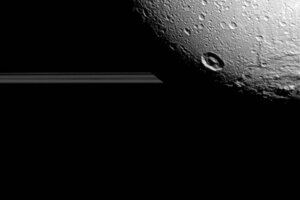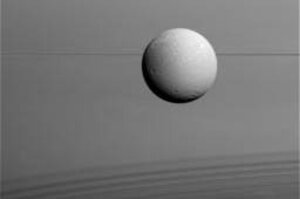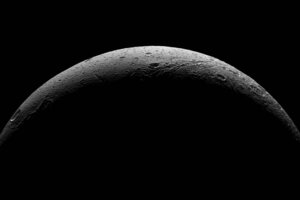Marvelous moon: See Cassini's detailed portraits of Saturn's Dione
The Cassini spacecraft passed above Dione’s surface Monday at a mere 295 miles, making it the fifth close encounter with the moon during its mission at Saturn.

Saturn's moon Dione hangs in front of Saturn's rings in this view taken by NASA's Cassini spacecraft during the inbound leg of its last close flyby of the icy moon. The image was acquired in visible light with the Cassini spacecraft narrow-angle camera on Aug. 17, 2015.
NASA/JPL-Caltech/Space Science Institute
NASA’s Cassini spacecraft made its final close approach to Saturn’s small, icy moon Dione this week, capturing new crystal clear images of its cratered surface.
The spacecraft passed above Dione’s surface Monday at a mere 295 miles, making it the fifth close encounter with the moon during its mission at Saturn. It made its closest flyby around Dione in December 2011 at a distance of 60 miles. The images arrived on Earth Thursday.
"I am moved, as I know everyone else is, looking at these exquisite images of Dione's surface and crescent, and knowing that they are the last we will see of this far-off world for a very long time to come," said Carolyn Porco, Cassini imaging team leader at the Space Science Institute in Boulder, Colo.
"Right down to the last, Cassini has faithfully delivered another extraordinary set of riches. How lucky we have been."
Scientists from NASA, the European Space Agency (ESA) and the Italian space agency, Agenzia Spaziale Italiana (ASI), launched Cassini in 1997 to orbit Saturn and study its system in detail over a four-year period.
With a scientific probe called Huygens onboard, the spacecraft reached Saturn in 2004. Since then, astronomers have been able to get a glimpse at the ringed planet’s diverse moons, the largest collection orbiting any planet in our solar system.
Because this week’s flyby focused on gravity science rather than imaging, Cassini’s camera wasn’t controlling where the spacecraft aimed, complicating its ability to capture clear images. Yet the craft managed to snap two photos of Dione with the highest resolution yet.
"We had just enough time to snap a few images, giving us nice, high resolution looks at the surface," said Tilmann Denk, a Cassini participating scientist at Freie University in Berlin.
"We were able to make use of reflected sunlight from Saturn as an additional light source, which revealed details in the shadows of some of the images."
Over the next few months, astronomers with the Cassini mission will study data from this gravity science experiment along with magnetosphere and plasma science instruments to search for clues about Dione’s interior structure and the processes affecting its surface.
Cassini will make only a handful of close flybys around Saturn’s large, icy moons this year. After December 2015, it will orbit the planet’s moons at greater distances until its mission comes to an end in late 2017. During the "Grand Finale," the mission’s final year, Cassini will repeatedly dive through space between Saturn and its rings.



